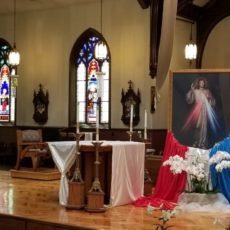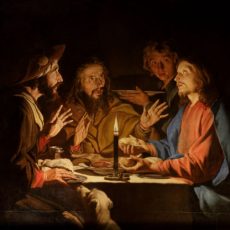A quick note about today’s Gospel… The two disciples on the road to Emmaus with Jesus. Jesus becomes recognizable to them when he “breaks the bread,” and then he vanishes. Jesus has instituted the Eucharist in order to be with us, wherever we are, all around the world, on whatever road. He comes to us now in Holy Communion. He breaks the bread, gives it to them, and then vanishes. What is left is the Eucharist and the believers, the recipients of the Eucharist. We see Christ in the Eucharist, and we also now see Christ in one another. He has become part of us, united with us, through the Eucharist. This also helps explain why Jesus told Mary Magdalene “not to cling to him” in an earlier Easter story, when she saw the risen Lord. How peculiar it was for him to say not to cling to him because he hadn’t yet risen to his Father. After he rises to his Father, he will come to us in a new way, a Eucharistic way. After that, we can “cling to him,” and him to us, because he comes to us in the Eucharist. He allows himself to be placed on our hand, on our tongue, and to become part of us, so that we can carry him around with us, inside of us. He will now be on every road, to every city, not only on the road to Emaus, through the Eucharistic “bread.”
Sunday – Easter – Week 2 – ABC – 2020

These are quick thoughts. Today we hear the story of Jesus’ appearance to the disciples in their room. Three times Jesus says, “Peace be with you.” He offers them peace, when he had every right to be upset. This shows his mercy. Peter had rejected him three times. Only one of the disciples was at the foot of the cross. None of them would stay up and pray with him the night of his arrest. He could have been made, but he offers peace, something unexpected, something merciful, love.
Thomas asks to see the wounds of Christ in order to believe. This story provides one explanation why God allows bad things to happen to good people. It is through the wounds that Thomas believes. Despite the wounds, despite Christ’s death, here Jesus was, standing before him. Alive and loving, Jesus was offering his friendship to Thomas again. This is something that converts people; it converted Thomas from being hard of heart to believing. When we can stand again with our wounds, alive, and loving; this is proof of the power and existence of God in his believers. It is difficult to recover from the sins of others and our own sins, but as Christians, there is every hope that even with our wounds, we can return to life and to a life of forgiveness, peace, and love. Thank God for his wonderful work of mercy.


